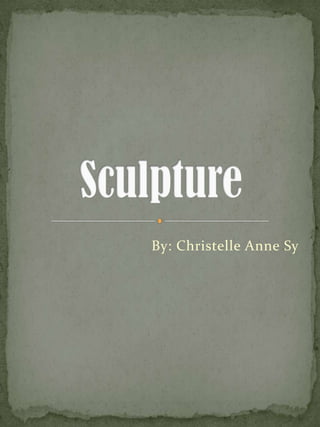Christelle\'s Lecheng Report.
- 1. By: Christelle Anne Sy
- 2. Sculpture is the act and art of making three- dimensional works of art such as statues. It is an artwork created by shaping or combining hard materials. Softer materials can also be used such as plastic, clay, polymer etc. Sculptures may be carved, chiseled, modeled, cast, or constructed.
- 3. Relief is "sculpture that projects in vary degrees from a two-dimensional background." Relief sculpture is among the oldest forms of sculpted art. Bas-relief has a very low degree of relief from the base, and is present in the surfaces of famous buildings such as the Parthenon in Greece. Alto-relief sculpture has a high degree of relief; the sculptures emerge from the flat base background, such as the sculptures of ancient pharaohs on their temples in Egypt. Sunken-relief sculptures are actually carved into the base itself and have a negative degree of relief.
- 4. Relief sculpture of the 2nd century CE found in Italy, now in the Terme Museum
- 5. Free-standing sculpture also known as sculpture in-the- round, likely represents the form of sculpture most recognizable to modern people. Free-standing sculpture is any work of sculpture which can be viewed from any angle around the pedestal. This kind of sculpture includes some of the most famous works of sculpture throughout time: the statuary works of the Greek, Roman, Medieval and Classical eras, including Michaelangelo's David.
- 6. Title: "Nike of Samothrace" Discovered in Greece
- 7. Kinetic sculpture is free-standing sculpture that moves, either by mechanical power or under the power of wind or water. Fountains are a form of kinetic sculpture, although in that special case the sculpture is not powered by the water but lives within the shapes and forms of the water as it arcs over and through the air.
- 8. ¡°Spira¡± located at Fort Lauderdale, Florida at the Broward County Courthouse.
- 9. Assemblage sculpture is sculpture pieced together from found or scavenged items that have little or no relationship to one another. Contemporary Art Dialogue's website defines assemblage art as "non-traditional sculpture, made from re-combining found objects. Some of these objects are junk from the streets." These pieced-together bits of castoff debris are arranged in an aesthetically pleasing shape to the artist and then presented to its audiences to provoke thought and reaction. Collages are a sort of two-dimensional representation of assemblage sculpture.
- 11. Carving is a process in which the artist subtracts or cuts away from a solid material to reach the desired form. It can be a very painstaking and time consuming method because of the hard and weighty materials, such as marble or other stones, that are often used. However, artists also carve softer substances such as wood and even soap.
- 13. Modeling is the process of manipulating soft materials to create a three-dimensional form. Unlike carving, modeling requires soft substances that can be easily and rapidly shaped by the sculptor's hands. Clay is the most frequent material used for modeling, however, others such as plaster, papier-mach¨¦, and wax are also common.
- 15. Casting is a method of obtaining the permanence of a modeled work by making a mold and casting it in a durable material such as bronze. Two methods of casting are used: sand casting and the cire-perdue or "lost wax" process. The lost-wax process is more widely used, however, both have been frequently employed since antiquity.
- 17. Construction and Assemblage Emerging in the twentieth- century, the techniques of assemblage and construction consist of combining and joining various materials to form a three-dimensional object. These methods originated from the technique collage, which was popularized by the Cubists during the early part of the twentieth century.
- 19. --END--



















